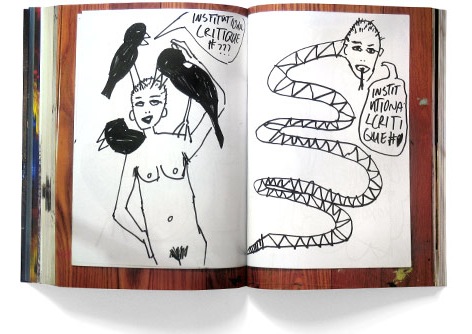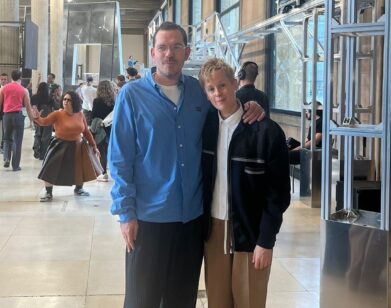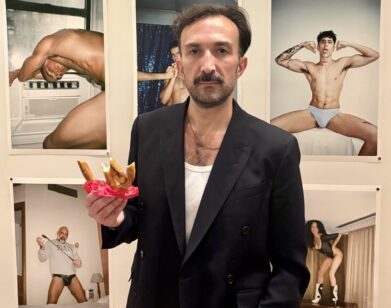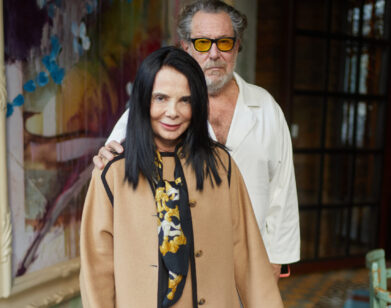Asher Penn: All for NOTHING

Cover, spread, from NOTHING NOTHING NOTHING NOTHING (An Art Service)
Working in an industry where the product can have limited shelf life, Interview appreciates the scrupulous appreciation to passing images paid by New York-based artist Asher Penn. He culls pictures from magazines, and instead of bemoaning their multiplicity, re-frames them to celebrate the poetry of their presentation. In his own work, Penn has a policy of non-editing: He shows all the photographs he takes in a session and all the works he makes in a series, privileging the preparation of the image and its framing. Penn’s NOTHING NOTHING NOTHING NOTHING (2004-2007) was recently published by An Art Service and launched at Maccarone. It collects four years and ten zines—a photograph of every publication the artist has ever produced. Fittingly, the cover is a picture of his tripod in the studio, before and after cataloguing the work. For the last six months, Penn has collected pages from magazines and cutting them into heart shapes and painting over them. The Heart Paintings opens this weekend at Real Fine Arts. We sat down to ask him about about opening his career with a retrospective.
ALEX GARTENFELD: When did you start work on your book?
AP: It was close to a year ago, almost exactly. Brendan Dugan [of An Art Service] had approached me. We talked about doing a book like an anthology, a compilation of the artist books that I had made. I was talking to a bunch of my friends, and asking them what I should do. The general consensus what that I should ask for the thing I never thought I would get. The most ridiculous thing I could ever ask for.
AG: And so you photographed every page of every book you’ve ever made.
AP: Yes. And every single book is photographed on a different surface of my apartment: the floor, a chair, a painting, a book, a wall, a couch. It was arbitrary. So my apartment becomes the subject matter. That was why the cover was the tripod; it was the one character that was very present in the whole thing.
AG: This was before the books by Harmony Korine’s Collected Fanzines or Jack Pierson’s book of eight fanzines had come out., where they reproduced the materials they had released to date.
AP: Yes. We were dealing with the same kind of materials. I asked for every single page, but we didn’t have the budget to scan or photograph them, so I just photographed everything myself.
AG: The photos came out really beautifully.
AP: They came out good. Jack Pierson is somebody who I admire and has accomplished a lot. He deserves a retrospective. Whereas with me… I hadn’t proved itself by any means. It was just something that I had made and it was actually really important that I showed every page from every book, even from ones that I don’t particularly like very much.
AG: There is a sense in which it is an autobiographical, but also an archival document.
AP: One of my major interests is framing my work in terms of the context and my point of view. Not looking at your work as an objective object but actually saying, “I made this thing and this is how I see it.”
AG: What was the first zine you made?
AP: Right after I graduated college in 2004. It’s tiny, you barely notice it at the beginning. It’s twelve pages and basically a catalogue of my senior thesis.
AG: So there wasn’t a body of work that necessarily preceded the books, where you said I want to put this into the form of a book. The books are the work itself, and they are about making the work.
AP: I started making these books in college, and in college you have a built-in audience. As soon as I graduated I realized the problem of sharing my work. I didn’t want to accept that if a certain group of people didn’t have any interest or I didn’t have a show that the work wouldn’t be seen. For me the work became something I could deal with and move on from, once it had been seen by someone else. Then I could move on and deal with it in a different way. So I became very productive with making artists books.
AG: You don’t like to edit your work.
AP: Editing is way of pair down your ideas and really clarifying what your ideas are. The problem I find is when you put so much emphasis into an image or an idea and hone it down, then this picture, this object, this moment… you run the risk of not making it clear how important that image and that moment or that idea is. So not editing seemed like a solution to be more emphatic about the choices. It’s like you thought this was an arbitrary thing, but it is not an arbitrary thing. This is something that is still there. “I looked at the thing this much; I did it this much.”
AG: Editing can be so much about renewal and really creating as part of writing
AP: I feel like my practice is non-editing. I think there are ways that you can frame a work from the inside. You can edit a work by not editing a work, especially when you are being honest about your desires.
AG: The experience lies in creating the image itself—
AP: In Asher Mixtape Hell, which was made years after graduating of college, I went through all the pictures I had considered to be failures in college and I re-engaged them and looked at them again. None of them were perfect, but they all articulated more about my interests than the “successful” photographs that I was showing at the time.
AG: You curse a lot in the titles.
AP: A lot of these books were made when I was younger. And some of the titles are very juvenile. I don’t regret any of them, but I’m certainly embarrassed by some of them.
Asher Penn’s “Heart Paintings” open Saturday, March 14, at Real Fine Arts, 6-9 PM. The gallery is located at 673 Meeker Avenue, Brooklyn, New York.






